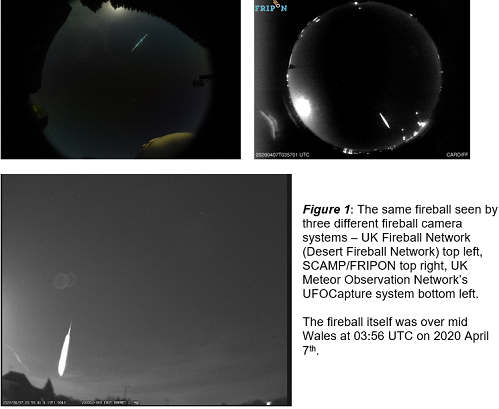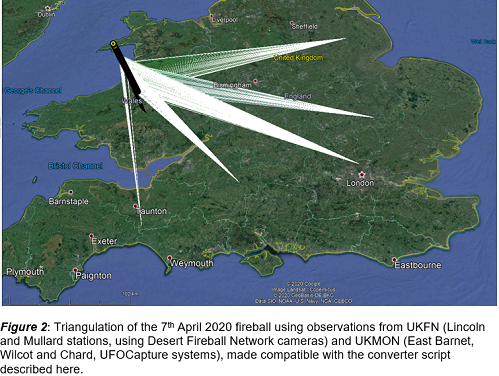Using incompatible fireball camera systems to find meteorites – towards a data exchange standard
- 1SCAMP fireball network, UK. (jim.rowe@scamp.org.uk)
- 2School of Geographical and Earth Sciences, University of Glasgow, Glasgow, G12 8QQ, UK
- 3Space Science and Technology Centre, School of Earth and Planetary Sciences, Curtin University, GPO Box U1987, Perth, WA, 6845, Australia
- 4Australian Centre for Microscopy and Microanalysis, The University of Sydney, NSW, 2006, Australia
- 5UK Fireball Network
- 6FRIPON, IMCCE, Observatoire de Paris, PSL Research University, CNRS UMR 8028, Sorbonne Université, Université de Lille, 77 av. Denfert-Rochereau, 75014, Paris, France
- 7Impact and Astromaterials Research Centre, Department of Earth Science and Engineering, Imperial College London, SW7 2AZ, UK
- 8Natural History Museum, London, SW7 5BD, UK
- 9Department of Earth Sciences, Royal Holloway University, Egham Hill, Egham TW20 0EX, UK
- 10University of Cambridge, Mullard Radio Astronomy Observatory, Cambridge Road, Harlton, Cambridgeshire, CB23 1EX, UK
- 11Cavendish Laboratory, University of Cambridge, Cambridge CB3 0HE, UK
- 12Newby Hall and Gardens, Ripon, Yorkshire, HG4 5AE, UK
- 13Galloway Astronomy Centre, Glasserton, Nr Whithorn, DG8 8NE, UK
- 14The Spaceguard Centre, Llanshay Lane, Knighton, LD7 1LW, UK
- 15UK Meteor Observation Network, UK
- 17School of Earth & Environmental Sciences, The University of Manchester, Oxford Rd, Manchester M13 9PL, UK
- 18Armagh Observatory and Planetarium, College Hill, Armagh BT61 9DB, UK
- 19Mineralogy & Petrology, Department of Natural Sciences, Amgueddfa Cymru – National Museum Wales, Cathays Park, Cardiff, CF10 3NP
- *A full list of authors appears at the end of the abstract
In the UK there are five meteor camera networks using four different camera and software systems that are aiming to recover meteorites. Utilising all observations of a fireball event from each network is crucial to constrain a precise orbit and fall position. However, the various camera systems generate a diversity of data outputs that are not compatible with each other. As a result, when a potentially meteorite-dropping fireball event occurs it is currently challenging to exchange calibrated observations between networks, which creates obstacles to response time and rapid meteorite recovery.
If recorded by at least two observatories, the fireball’s trajectory, pre-arrival orbit, final mass, and (in combination with a ‘dark flight’ model) the final fall position of any surviving meteorite can also be calculated. For this, the minimum useful data set from each camera consists of (a) the location of the observatory, and (b) a set of timed direction vectors representing each point at which the meteor was observed. While the inclusion of additional data are recommended, this is the minimum required dataset for a fireball observation from a single camera, that can be exchanged between cooperating fireball networks to provide for accurate triangulation.
Camera systems currently used in the UK or considered as candidates for adoption as a data exchange standard are:
- UFOAnalyzer. Used by UK Meteor Observation Network and the NEMETODE network, UFOAnalyzer’s “A.XML” file contains the essential and recommended data in XML format. UFOAnalyzer is widely used by amateurs in the UK, Western Europe, and Japan.
- Raspberry Meteor System (RMS, or Global Meteor Network). Increasingly deployed in the UK. Observations are recorded in two files, the “CAL” file containing all essential metadata, and the “FTPDetect” file containing data for all meteors observed in any given night.
- Desert Fireball Network (DFN), UK Fireball Network, Global Fireball Observatory – generates a single file with all essential and recommended data, written in Astropy ECSV table format.
- FRIPON, SCAMP - produces a file in Pixmet or SExtractor format, but lacking metadata, which needs to be added from a separate list of observatory parameters.
- Cameras for Allsky Meteor Surveillance (CAMS) – similar to RMS. Used in Benelux countries, which have occasional observational overlap with the UK
- Virtual Meteor Observatory (VMO)1 – an XML single-meteor format used by some German and Polish networks and by the European Space Agency (ESA). Not yet used in the UK.
Three existing fireball data formats (UFOAnalyzer, VMO and DFN) are identified and evaluated as candidates for information exchange between networks. Each is adequate, though the UFOAnalyzer A.XML format would need to be generalised to be unambiguous. Each can be read with standard Python library routines. Currently it would appear that the DFN format is the easiest to write using standard library routines and the easiest to represent internally as a data structure. We are working towards a recommendation for the standard format for fireball data exchange.
Agreeing a common data format enables data sharing but does not require it. Whilst the minimum dataset described above can be utilised effectively, additional information to refine the accuracy of the measurement is also highly desirable and should be included. This recommended data set includes additional information regarding the observing system and uncertainties and additional observations of the event observed at each point in time and will be discussed in detail at the meeting.


We have also developed and present a new converter script that can convert UFOAnalyzer and Desert Fireball Network files to any agreed standard format. Based on a Jupyter notebook kindly provided by Hadrien Devillepoix of the Desert Fireball Network in Australia, the converter was further developed by SCAMP and is now being developed jointly by the authors.
Whilst it is feasible to produce a converter for a single static format such as UFOAnalyzer’s “A.XML”, it is not practicable to write and maintain a reliable converter program for the multiplicity of file formats that exist now or may exist in the future. As such this converter program represents a stopgap while a global fireball data exchange standard is established.
Conclusion and Recommendation
Meteorite recovery is inhibited in countries where multiple incompatible fireball camera systems are used. Adopting a common file format that could be read by each system would greatly assist in the observation and recovery of new meteorite falls with orbits. Pending further consultation, our draft recommendation is adoption of the DFN data format as a global standard for fireball data exchange.
References
1 Ceplecha, Z. (1987) Geometric, Dynamic, Orbital and Photometric Data on Meteoroids From Photographic Fireball Networks. Bulletin of the Astronomical Institutes of Czechoslovakia 38, 222.
2 Devillepoix, H. A. R., Cupák, M., Bland, P. A., Sansom, E. K., Towner, M. C., Howie, R. M., ... & Benedix, G. K. (2020). A Global Fireball Observatory. arXiv preprint arXiv:2004.01069.
3 Sansom, E. K., Rutten, M. G., Bland, P. A. (2017). Analyzing Meteoroid Flights Using Particle Filters. The Astronomical Journal 153, 87-96.
4 SonotaCo (2009). “A meteor shower catalog based on video observations in 2007-2008”. WGN, Journal of the International Meteor Organization, 37, 55–62.
5 Vida, D., Mazur, M. J., Segon, D., Zubovic, D., Kukic, P., Parag, F., & Macon, A. (2018). First results of a Raspberry Pi based meteor camera system. WGN, the Journal of the International Meteor Organisation 46(2), 71-78.
6 Bertin, E., Arnouts, S. (1996.) SExtractor: Software for source extraction. Astronomy and Astrophysics Supplement Series 117, 393-404.
7 Jenniskens, P., Gural, P. S., Dynneson, L., Grigsby, B. J., Newman, K. E., Borden, M., Koop, M., Holman, D. (2011). CAMS: Cameras for Allsky Meteor Surveillance to establish minor meteor showers. Icarus 216(1), 40-61.
8 Barentsen, G., Arlt, R., Koschny, D., … & Zoladek, P. (2010). The VMO file format. I. Reduced camera meteor and orbit data. WGN, the Journal of the International Meteor Organisation 38(1), 10-24.
UKFAll
How to cite: Rowe, J., Daly, L., McMullan, S., Devillepoix, H., Collins, G., Suttle, M., Chan, Q., Young, J., Shaw, C., Mardon, A., Alexander, M., Tate, J., Cupak, M., Campbell-Burns, P., Kacerek, R., Joy, K., Christou, A., Horák, J., Shepherd, J., and Colas, F. and the The UK Fireball Alliance: Using incompatible fireball camera systems to find meteorites – towards a data exchange standard, Europlanet Science Congress 2020, online, 21 Sep–9 Oct 2020, EPSC2020-856, https://doi.org/10.5194/epsc2020-856, 2020.

